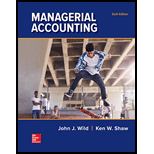
Concept explainers
Concept introduction:
Days’ payable outstanding:
Days’ payable outstanding tells about the number of days a company takes to repay its’ creditors. In other words we can say that it shows relationship between accounts payable and cost of goods sold. Low number of days shows that a company is paying creditors quickly but higher the number of days shows that a company is not able to pay creditors quickly.
Requirement 1:
Days’ payable outstanding for the current year.
Concept introduction:
Days’ payable outstanding:
Days’ payable outstanding tells about the number of days a company takes to repay its’ creditors. In other words we can say that it shows relationship between accounts payable and cost of goods sold. Low number of days shows that a company is paying creditors quickly but higher the number of days shows that a company is not able to pay creditors quickly.
Requirement 2:
By how many days would days’ payable outstanding be reduced?
Concept introduction:
Days’ payable outstanding:
Days’ payable outstanding tells about the number of days a company takes to repay its’ creditors. In other words we can say that it shows relationship between accounts payable and cost of goods sold. Low number of days shows that a company is paying creditors quickly but higher the number of days shows that a company is not able to pay creditors quickly.
Requirement 3:
By how many days would days’ payable outstanding be increased?
Want to see the full answer?
Check out a sample textbook solution
Chapter C Solutions
Managerial Accounting
- Carla Vista Company had $212,200 of net income in 2024 when the unit selling price was $151, the unit variable costs were $95, and the fixed costs were $571,800. Management expects per unit data and total fixed costs to remain the same in 2025. The president of Carla Vista Company is under pressure from stockholders to increase net income by $84,000 in 2025. Assume that Carla Vista Company sells the same number of units in 2025 as it did in 2024. What would the unit selling price have to be in order to reach the stockholders' desired net income, assuming the unit variable costs and fixed costs remain at 2024 levels? New unit selling price $arrow_forwardEric Greenhills, a partner in the CPA firm of XYZ & Co. LLP, audited the financial statements of ABC. Company. The audit report can be signed by Eric Greenhills XYZ & Co., LLP a Yes Yes b No No c Yes No d No Yes is the correct answer c yes ,no or a yes, yes ??arrow_forwardDonald Diesel owns the Fredonia Barber Shop. He employs 5 barbers and pays each a base salary of $1,380 per month. One of the barbers serves as the manager and receives an extra $535 per month. In addition to the base salary, each barber also receives a commission of $3.75 per haircut. Other costs are as follows. Advertising $270 per month Rent $1,010 per month Barber supplies $0.50 per haircut Utilities $160 per month plus $0.15 per haircut Magazines $35 per month Donald currently charges $11.00 per haircut. Determine the unit variable costs per haircut and the total monthly fixed costs. (Round variable costs to 2 decimal places, e.g. 2.25.) Total unit variable cost per haircut $ Total fixed costs $arrow_forward
- Solve this problem urgarrow_forwardCarla Vista Company had $212,200 of net income in 2024 when the unit selling price was $151, the unit variable costs were $95, and the fixed costs were $571,800. Management expects per unit data and total fixed costs to remain the same in 2025. The president of Carla Vista Company is under pressure from stockholders to increase net income by $84,000 in 2025. Compute the number of units that would have to be sold in 2025 to reach the stockholders' desired net income. Units needed in 2025 unitsarrow_forwardSolve this Accounting problemarrow_forward
- Question 5.5arrow_forwardCarla Vista Company had $212,200 of net income in 2024 when the unit selling price was $151, the unit variable costs were $95, and the fixed costs were $571,800. Management expects per unit data and total fixed costs to remain the same in 2025. The president of Carla Vista Company is under pressure from stockholders to increase net income by $84,000 in 2025. (a) Compute the number of units sold in 2024. Sales in 2024 unitsarrow_forwardThe sales level in units requiredarrow_forward
 EBK CONTEMPORARY FINANCIAL MANAGEMENTFinanceISBN:9781337514835Author:MOYERPublisher:CENGAGE LEARNING - CONSIGNMENT
EBK CONTEMPORARY FINANCIAL MANAGEMENTFinanceISBN:9781337514835Author:MOYERPublisher:CENGAGE LEARNING - CONSIGNMENT College Accounting, Chapters 1-27 (New in Account...AccountingISBN:9781305666160Author:James A. Heintz, Robert W. ParryPublisher:Cengage Learning
College Accounting, Chapters 1-27 (New in Account...AccountingISBN:9781305666160Author:James A. Heintz, Robert W. ParryPublisher:Cengage Learning Survey of Accounting (Accounting I)AccountingISBN:9781305961883Author:Carl WarrenPublisher:Cengage Learning
Survey of Accounting (Accounting I)AccountingISBN:9781305961883Author:Carl WarrenPublisher:Cengage Learning Managerial AccountingAccountingISBN:9781337912020Author:Carl Warren, Ph.d. Cma William B. TaylerPublisher:South-Western College Pub
Managerial AccountingAccountingISBN:9781337912020Author:Carl Warren, Ph.d. Cma William B. TaylerPublisher:South-Western College Pub




